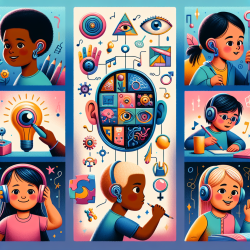Understanding and improving emotion processing skills in teens with Autism Spectrum Disorders (ASD) is crucial for practitioners aiming to enhance social cognition and integration. A recent study titled "Neurofunctional Underpinnings of Audiovisual Emotion Processing in Teens with Autism Spectrum Disorders" offers valuable insights into the brain activity differences between teens with ASD and typically developing controls during audiovisual and unimodal emotion processing. This blog post will delve into the findings and suggest how practitioners can apply these insights to their therapeutic approaches.
The Study: Key Findings
The study utilized functional magnetic resonance imaging (fMRI) to examine brain activity in 18 teens with ASD and 16 typically developing controls. The research revealed several important findings:
- Accuracy in Emotion Matching: Teens with ASD showed significantly lower accuracy when matching an emotional face to an emotion label compared to controls. However, no significant differences were found when matching an emotional voice or face-voice pair to an emotion label.
- Differential Brain Activation: During audiovisual emotion matching, teens with ASD exhibited greater activation in a parietofrontal network associated with attention, goal-directed behaviors, and semantic processing. In contrast, typically developing controls showed greater activity in frontal and temporal association cortices.
- Compensatory Mechanisms: The findings suggest that teens with ASD may rely on alternate compensatory systems, such as the parietofrontal network, due to hypoactivity in integrative emotional networks.
Implications for Practitioners
The study's outcomes provide a foundation for practitioners to refine their therapeutic strategies. Here are some practical applications:
- Focus on Auditory Cues: Given that individuals with ASD may favor auditory over visual cues, therapists can incorporate more auditory-based activities to enhance emotion recognition skills.
- Cognitive Strategies: Encourage the use of cognitive strategies that leverage the parietofrontal network's strengths in attention modulation and goal-directed behavior.
- Integration of Multimodal Stimuli: Design interventions that gradually increase the complexity of multimodal stimuli to improve integration skills without overwhelming the individual.
The Path Forward: Encouraging Further Research
This study highlights the need for continued exploration into the neurofunctional mechanisms underlying emotion processing in individuals with ASD. Practitioners are encouraged to stay informed about emerging research through conferences, publications, and webinars. Engaging in collaborative research efforts can also lead to more effective therapeutic techniques tailored to the unique needs of individuals with ASD.
To read the original research paper, please follow this link: Neurofunctional Underpinnings of Audiovisual Emotion Processing in Teens with Autism Spectrum Disorders.










